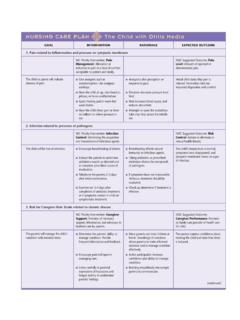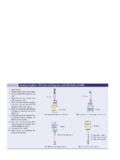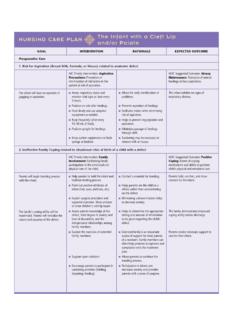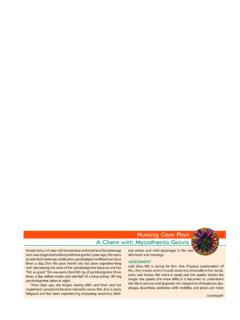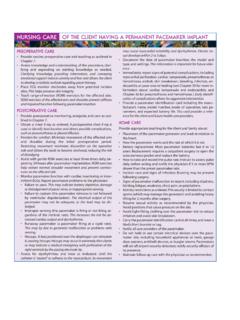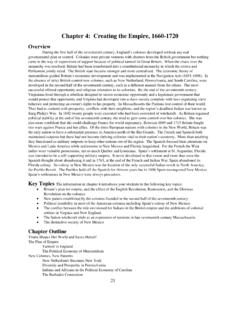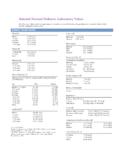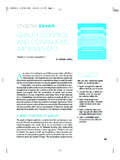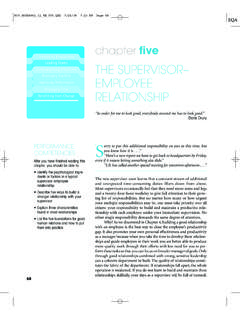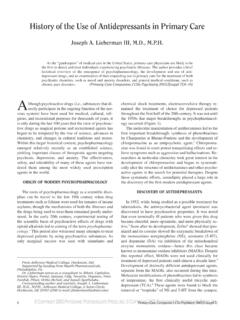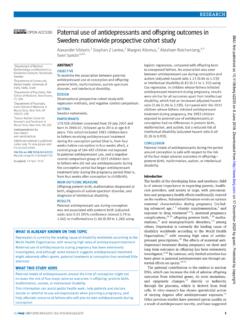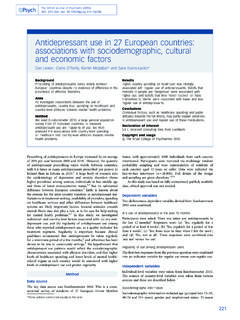Transcription of NURSING PROCESS FOCUS Clients Receiving Antidepressant ...
1 Chapter 16 Drugs for Emotional and Mood Disorders197 AssessmentPotential NURSING DiagnosesPrior to administration: Obtain a complete health history including allergies, family history of mooddisorders, and possible drug interactions. Establish baseline assessment of mood disorder. If possible, use a brief objec-tive tool. Frequency of assessment will relate to the severity of the mood disorder. Obtain history of cardiac (including recent MI), renal, biliary, liver, and mentaldisorders including ECG and blood studies: CBC, platelets, glucose, blood ureanitrogen (BUN), creatinine, electrolytes, liver function tests and enzymes, andurinalysis. Assess neurologic statusal, including seizure activity and identification ofrecent mood and behavior patterns.
2 Coping, Ineffective Powerlessness Thought Processes, Disturbed, related to side effects of drug, lack of positivecoping skills Knowledge, Deficient, related to drug therapy Violence: Self-directed, Risk for Urinary Retention, related to anticholinergic side effects of drug Noncompliance, related to decreased sexual libido and/or weight gain Risk for Injury, related to adverse side effects Self-Care, Deficient, related to fatigue Nutrition, Imbalanced, Less than body requirements, related to anorexia Nutrition, Imbalanced, More than body requirements, related to side effectsof medication or eating for comfort Grieving, Dysfunctional, related to loss (such as loss of health, job, significantother, etc.)Planning: Client Goals and Expected OutcomesThe client will: Report mood elevation (may use short objective tool, such as the Beck Depression Tool).
3 Remain safe from self-harm or harm directed toward others. Actively engage in self-care activities. Report abilty to fall asleep and stay asleep as was able to do before depression. Demonstrate an understanding of the drug s action by accurately describing drug side effects and and (Rationales)Client Teaching/Discharge Planning Monitor vital signs, especially pulse and blood pressure, especially when initi-ating treatment. (Imipramine may cause orthostatic hypotension.) Administer accurately. Give TCAs at bedtime to aid in sleep and minimize daytimedrowsiness. (Always practice safe techniques of medication administration. Givingmedication at bedtime will minimize the side effect of drowsiness.) Observe for signs and symptoms of improved mood, keeping in mind that itmay take 2 to 4 weeks to achieve therapeutic effectiveness.
4 (The risk of suicidemay increase as energy levels rise.) Observe for serotonin syndrome in SSRI use. (If suspected, discontinue drug and ini-tiate supportive care. Respond according to ICU/emergency department protocols.) Monitor for paradoxical diaphoresis. (This must be considered a significant sign,especially serious when coupled with nausea or vomiting or chest pain.) Monitor cardiovascular status. (Hypertension and stroke or MI and heart fail-ure may be observed.) Monitor neurological status. Observe for somnolence and seizures. (TCAsmay cause somnolence related to CNS depression. May reduce the seizurethreshold.)Instruct client to: Report any change in sensorium, particularly impending syncope. Avoid abrupt changes in position.
5 Monitor vital signs (especially blood pressure) properly using home equipment Consult the nurse regarding reportable blood pressure readings ( , lowerthan 80/50 mm Hg). Instruct client to take medication at bedtime to decrease daytime client: That it may take 2 to 4 weeks for mood to improve. To report any feelings of suicide. Inform client that overdosage may result in serotonin syndrome, which can belife threatening. Instruct client to seek immediate medical attention for dizziness, headache, tremor,nausea/vomiting, anxiety, disorientation, hyperreflexia, diaphoresis, and fever. Instruct client to immediately report severe headache, dizziness, paresthesias,bradycardia, chest pain, tachycardia, nausea or vomiting, or client to: Report significant changes in neurological status, such as seizures, extremelethargy, slurred speech, disorientation, or ataxia, and discontinue the drug.
6 Take dose at bedtime to avoid daytime sedation.(Continued) NURSING PROCESS FOCUSC lients Receiving Antidepressant TherapyADAMMC16_0131756656 2/10/07 09:06 PM Page 197 Team B 107:PEQY046:phada2:ch16:198 Unit 3 The Nervous System Monitor mental and emotional status. Observe for suicidal ideation. (Therapeuticbenefits may be delayed. If severely depressed, outclients should have no morethan a 7-day medication supply.) Monitor for underlying or concomitantpsychoses such as schizophrenia or bipolar disorders. (The drug may trigger manicstates.) When used as antianxiety agents, client may need temporary antianxietyagent or sleep aid. (Therapeutic levels are not immediately reached.). Observe for anticholinergic or antiadrenergic adverse effects.
7 (Cardiovasculareffects are most serious, but other unwanted effects include CNS symptoms,gastrointenstinal problems, blurred vision, urinary retention, sexual dysfunc-tion, and weight gain). Monitor sleep wake cycle. Observe for insomnia and/or daytime baseline data on onset and duration of sleep disorder. (Baseline dataprovide information as to whether symptoms are improving.) Monitor renal status and urinary output. (This drug may cause urine retentionowing to muscle relaxation in urinary tract. Imipramine is excreted throughthe kidneys. Fluoxetine is slowly metabolized and excreted, increasing the riskof organ damage. Urinary retention may exacerbate existing symptoms of pro-static hypertrophy.) Use cautiously with elderly or young Clients .
8 (Diminished kidney and liverfunction related to aging can result in higher serum drug levels, and may re-quire lower doses. Children, owing to an immature CNS, respond paradoxicallyto CNS drugs.) Monitor gastrointestinal status. Observe for abdominal distention. (Muscarinicblockade reduces tone and motility of intestinal smooth muscle, and maycause paralytic ileus.) Monitor liver function and blood studies including CBC, differential,platelets, prothrombin time (PT), partial thromboplastin time (PTT), and liverenzymes. (These results determine signs and symptoms of hepatotoxicity.) Monitor hematologic status. Observe for signs of bleeding. (Imipramine maycause blood dyscrasias. Use with warfarin may increase bleeding time.)
9 Monitor immune/metabolic status. Use with caution in Clients with diabetesmellitus or hyperthyroidism. (If given in hyperthyroidism, it can cause agranu-locytosis. Imipramine may either increase or decrease serum glucose. Fluoxe-tine may cause initial anorexia and weight loss, but with prolonged therapymay result in weight gain of up to 20 lb.)Instruct client: To immediately report dysphoria or suicidal impulses To commit to a no-self-harm verbal contract That it may take 10 to 14 days before improvement is noticed, and about1 month to achieve full therapeutic effect. Instruct client to report any changes bowel or bladder routines, blurred vision,weight gain, or sexual client to: Take drug very early in the morning if insomnia occurs, to promote normaltiming of sleep onset.
10 Avoid driving or performing hazardous activities until effects of drug are known. Take at bedtime if daytime drowsiness persists. Follow principles of sleep client to: Monitor fluid intake and output. Notify the healthcare provider of edema, dysuria (hesitancy, pain, diminishedstream), changes in urine quantity or quality ( , cloudy, with sediment). Report fever or flank pain that may indicate a urinary tract infection related tourine retentionInstruct client that: The elderly may be more prone to side effects such as hypertension anddysrhythmias. Children on imipramine for nocturnal enuresis may experience mood client to: Exercise, drink adequate amounts of fluid, and add dietary fiber to promotestool passage.

